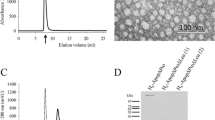Abstract
The authors established apoptosis resistant COS–1, myeloma, hybridoma, and Friend leukemia cell lines by genetically engineering cells, aiming at more efficient protein production by cell culture. COS–1 cells, which are most widely used for eukariotic gene expression, were transfected with human bcl–2 gene. Both bcl–2 and mock transfected COS–1 cells were cultured at low (0.2%) serum concentration for 9 days. The final viable cell number of the bcl–2 transfected cells was ninefold of that of the mock transfectants. Both bcl–2 and mock transfectants were further transfected with the vector pcDNA-λ containing SV40 ori and immunoglobulin λ gene for transiently expressing λ protein. The bcl–2 expressing COS–1 cells produced more λ protein than the mock transfected COS–1 cells after 4 days posttransfection.
Mouse myeloma p3-X63-Ag.8.653 cells, which are widely used as the partner for preparing hybridoma, and hybridoma 2E3 cells were transfected with human bcl–2 gene. Both bcl–2 transfected myeloma and hybridoma survived longer than the corresponding original cells in batch culture. The bcl–2 transfected 2E3 cells survived 2 to 4 four days longer in culture, producing 1.5- to 4-fold amount of antibody in comparison with the mock transfectants.
Coexpression of bag–1 with bcl–2 improved survival of hybridoma 2E3 cells more than bcl–2 expression alone. The bag–1 and bcl–2 coexpressing cells produced more IgG than the the cells expressing bcl–2 alone.
Apoptosis of Friend murine erythroleukemia(F-MEL) cells was suppressed with antisense c-jun expression. The antisense c-jun expressing cells survived 16 days at non-growth state.
Similar content being viewed by others
References
Duval D, Demangel C, Geahel I, Blondeau K and Marcaded A (1990) Comparison of various methods for monitoring hybridoma cell proliferation. J Immunol Meth 134: 177–185.
Franěk F and Chládková-Šrámková K (1995) Apoptosis and nutrition: Involvement of amino acid transport system in repression of hybridoma cell death. Cytotechnology 18: 113–117.
Glacken MW, Adema E and Sinskey AJ (1988) Mathematical descriptions of hybridoma culture kinetics: I. initial metabolic rates. Biotechnol Bioeng 32: 491–506.
Itoh Y, Ueda H and Suzuki E (1995) Overexpression of bcl-2, apoptosis suppressing gene: prolonged viable culture period of hybridoma and enhanced antibody production. Biotechnol Bioeng 48: 118–122.
Karasuyama H, Kudo A and Melchers F (1990) The proteins encoded by the VpreB and λ5 pre-B cell-specific genes can associate with each other and with μ heavy chain. J Exp Med 172: 969–972
Makishima F, Terada S, Mikami T and Suzuki E (1992) Interleukin-6 is antiproliferative to a mouse hybridoma cell line and promotive for its antibody productivity. Cytotechnology 10: 15–23.
Mellon P, Parker V, Gluzman Y and Maniatis T (1981) Identification of DNA sequences required for transcription of SV40 host-vector system. Cell 27: 279–288.
Mercille S and Massie B (1994) Induction of apoptosis in nutrient-deprived cultures of hybridoma and myeloma cells. Biotechnol Bioeng 44: 1140–1154.
Nunez G, London L, Hockenberry D, Alexander M, McKearn JP and Korshmeyer H (1990) Deregulated bcl-2 gene expression selectively prolongs survival of growth factor-deprived haempoietic cell lines. J Immunol 144: 3602–3610.
Singh RP, Al-Rubeai M, Gregory CD and Emery AN (1994) Cell death in bioreactors: a role for apoptosis. Biotechnol Bioeng 44: 720–726.
Smith MJ and Prochownik EV (1992) Inhibition of c-jun causes reversible proliferative arrest and withdrawal from the cell cycle. Blood 79: 2107–2115.
Suzuki E and Ollis DF (1990) Enhanced antibody production at slowed growth rates: experimental demonstration and a simple structured model. Biotechnol Prog 6: 231–236.
Takahashi K, Terada S, Ueda H, Makishima F and Suzuki E (1994) Growth rate suppression of cultured mammalian cells enhances protein productivity. Cytotechnology 12: 1–8
Takayama S, Sato T, Krajewski S, Kochel K, Irie S, Millan JA and Reed JC (1995) Cloning and functional analysis of BAG-1: a novel Bcl-2 binding protein with anti-cell death activity. Cell 80: 279–284.
Tohyama N, Karasuyama H and Tada T (1990) Growth autonomy and tumorigenicity of interleukin-6-dependent B cells transfected with interleukin-6 cDNA. J Exp Med 171: 389–400.
Tsujimoto Y (1989) Stress-resistance conferred by high level of bcl-2a protein in human B lymphoblastoid cell. Oncogene 4: 1331–1336.
Vaux DL, Cory S and Adams JM (1988) Bcl-2 gene promotes haemopoietic cell survival and cooperates with c-myc to immortalise pre-B cells. Nature 335: 440–442.
Vomastek T and Franěk F 1993. Kinetics of development of spontaneous apoptosis in B cell hybridoma cultures. Immunol Lett 35: 19–24.
Author information
Authors and Affiliations
Rights and permissions
About this article
Cite this article
Suzuki, E., Terada, S., Ueda, H. et al. Establishing apoptosis resistant cell lines for improving protein productivity of cell culture. Cytotechnology 23, 55–59 (1997). https://doi.org/10.1023/A:1007942929800
Issue Date:
DOI: https://doi.org/10.1023/A:1007942929800




